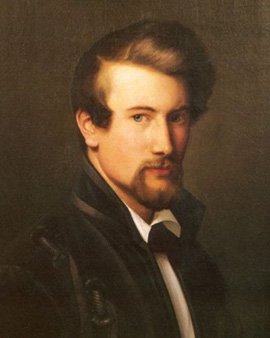Adolph Tidemand is considered one of the leading Norwegian painters of the 19th century. Like no other before him, he was able to capture the hard life and traditional customs of the Nordic farmers in his paintings. He thus not only inspired the poets of his homeland, including Andreas Munch and Bjørnstärn Bjørnson, but is still the main character of Norwegian Romanticism today. The second half of the 1840s is often understood as Adolph Tidemand's artistic heyday. He created his most famous works such as "Wedding in Hardanger" and "The Lonely Old Men" at the height of his success. Tidemands began his career with paintings that had a strongly idealizing depiction of farmers. This gave way in his later works; in favour of a dramatic and realistic depiction of the living conditions of the simple rural population and their hard everyday life. This can be clearly seen in paintings such as "Fighting at a Peasant Wedding" and "The Fanatics" from his late work.
Tidemand was a classical Academy painter. He enjoyed an excellent education as a student of painter Johan Ludvig Lund at the renowned Academy of Fine Arts in Copenhagen. He then became a student of history painting at Theodor Hildebrandt and Wilhelm Schadow in Düsseldorf. There Tidemands dream was formed to become a successful history painter. Already with his first historical composition ("Gustav Vasa talks to the mayor in the church of Mora") the young painter was able to attract the attention of the art scene of that time. The painting, which shows a part of Swedish history, was later acquired by the Rhineland and Westphalia Art Association.
A scholarship enabled Tidemand to travel to Rome, where he became acquainted with Italian painting, which influenced his painting style. He did not return to Norway, but settled in Germany. There he stayed for the rest of his life. The ambitious painter used visits to his home country as study trips. In the rural areas of Norway, he encountered a rural environment that had retained much of its authenticity. Here he finally found his life's work: to immortalize the real Norway in pure and refined pictures. Tidemand's first sketches, studies and paintings on this subject are characterized by an idyllic, slightly elegant expression and fine painterly values. He later confidently replaced the idyll with a more dramatic tension and a sober view of the life of the farmers.
×





.jpg)
.jpg)
.jpg)
.jpg)
.jpg)
.jpg)
.jpg)
.jpg)
_-_(MeisterDrucke-1403806).jpg)
_-_(MeisterDrucke-1403806).jpg)
.jpg)
.jpg)
.jpg)
.jpg)
.jpg)
.jpg)
.jpg)
.jpg)
.jpg)
.jpg)
.jpg)
.jpg)
.jpg)
.jpg)
.jpg)
.jpg)
.jpg)
.jpg)
.jpg)
.jpg)
.jpg)
.jpg)
.jpg)
.jpg)
.jpg)
.jpg)
.jpg)
.jpg)
.jpg)
.jpg)
.jpg)
.jpg)
.jpg)
.jpg)
.jpg)
.jpg)
.jpg)
.jpg)
.jpg)
.jpg)
.jpg)
.jpg)
.jpg)
.jpg)
.jpg)
.jpg)
.jpg)
.jpg)
.jpg)
.jpg)
.jpg)
.jpg)
.jpg)
.jpg)
.jpg)
.jpg)
.jpg)
.jpg)
.jpg)
.jpg)
_Gulsvik_-_(MeisterDrucke-1455446).jpg)
_Gulsvik_-_(MeisterDrucke-1455446).jpg)
.jpg)
.jpg)
.jpg)
.jpg)
_-_(MeisterDrucke-1408072).jpg)
_-_(MeisterDrucke-1408072).jpg)
.jpg)
.jpg)
.jpg)
.jpg)
.jpg)
.jpg)
.jpg)
.jpg)
_-_(MeisterDrucke-1534486).jpg)
_-_(MeisterDrucke-1534486).jpg)
.jpg)
.jpg)
.jpg)
.jpg)
.jpg)
.jpg)
.jpg)
.jpg)
.jpg)
.jpg)
_-_(MeisterDrucke-1403842).jpg)
_-_(MeisterDrucke-1403842).jpg)
.jpg)
.jpg)
.jpg)
.jpg)
_-_(MeisterDrucke-1413779).jpg)
_-_(MeisterDrucke-1413779).jpg)
.jpg)
.jpg)
.jpg)
.jpg)
_-_(MeisterDrucke-1544521).jpg)
_-_(MeisterDrucke-1544521).jpg)
.jpg)
.jpg)
.jpg)
.jpg)
_-_(MeisterDrucke-1413780).jpg)
_-_(MeisterDrucke-1413780).jpg)
.jpg)
.jpg)
.jpg)
.jpg)
.jpg)
.jpg)
.jpg)
.jpg)
.jpg)
.jpg)
.jpg)
.jpg)
.jpg)
.jpg)
.jpg)
.jpg)
.jpg)
.jpg)
.jpg)
.jpg)
.jpg)
.jpg)
.jpg)
.jpg)
.jpg)
.jpg)
.jpg)
.jpg)
.jpg)
.jpg)
.jpg)
.jpg)
_-_(MeisterDrucke-1543825).jpg)
_-_(MeisterDrucke-1543825).jpg)
.jpg)
.jpg)
.jpg)
.jpg)
.jpg)
.jpg)
.jpg)
.jpg)
.jpg)
.jpg)
.jpg)
.jpg)
_-_(MeisterDrucke-1407429).jpg)
_-_(MeisterDrucke-1407429).jpg)
.jpg)
.jpg)
.jpg)
.jpg)
.jpg)
.jpg)
.jpg)
.jpg)
.jpg)
.jpg)
.jpg)
.jpg)
.jpg)
.jpg)
.jpg)
.jpg)
.jpg)
.jpg)
.jpg)
.jpg)
.jpg)
.jpg)
.jpg)
.jpg)
.jpg)
.jpg)
.jpg)
.jpg)
.jpg)
.jpg)
.jpg)
.jpg)
.jpg)
.jpg)






